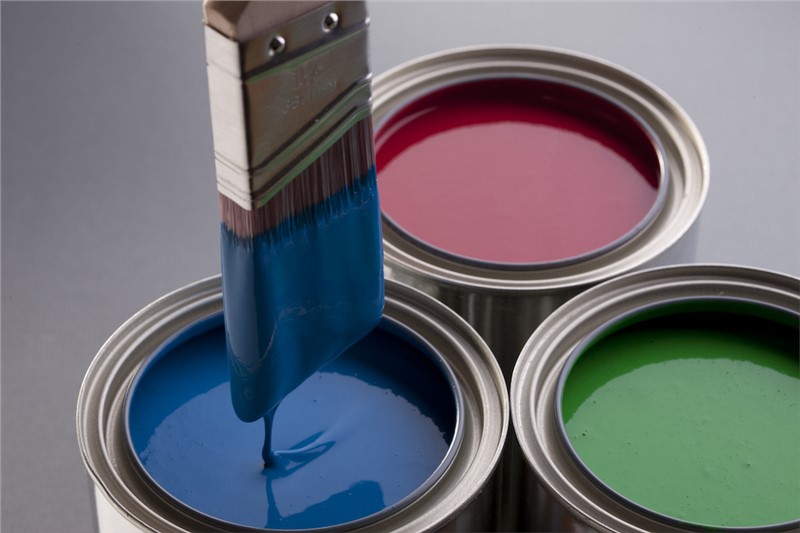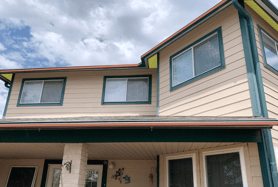How much does an exterior paint job cost? Top 5 factors
June 21st, 2021 | 8 min. read
Get weekly updates with the most recent articles and videos from Southwest Exteriors.
Subscribe
Photo credit: United Soybean Board. This image was not changed in any way.
It’s a hot, Texas summer morning, and you make your way up and down the lawn with your push mower to keep your front yard looking fresh.
As you make your way along one side of your house, you look over and notice multiple spots where the paint is chipping away.
When you think of it, you can’t remember the last time you got the exterior of your home painted. So you think, “I better look for a professional contractor, but how much is that going to cost me?”
An exterior paint job can cost anywhere from $3,000-6,000 as a starting point for 12 squares of siding, soffit, and fascia. A square refers to a 10 ft. x 10 ft. area or 100 square feet. The cost to get your exterior painted, however, varies and ranges depending on many factors.
Southwest Exteriors offers expert exterior painting for all types of siding and has been a local home remodeling contractor for over 30 years. We know the details that influence the cost of an exterior paint job and want to be completely transparent about all that goes into it.
In the painting industry, some contractors are dishonest and take the easy way around things to save them money while charging you more.
We want to combat that and inform you of the factors that will influence the cost of an exterior paint job so you know what to expect when looking to get your exterior painted.
This article will outline the top five factors that impact the cost of an exterior paint job: total square footage of the project, degree of difficulty of the area, type and condition of the area, paint color, and contractor quality.
After reading, you will have a better understanding of what goes into the total price to
know what you want to be included in your job and avoid any confusion or surprises in your cost.
1. Square footage of the project
Like many home remodeling projects, the size of the project is the greatest influence on the total cost.
For painting, the square footage and price are calculated by how many squares are a part of the project. A square refers to a 10 ft. x 10 ft. area or 100 square feet.
A project that is only one square will be much less expensive than a project that is eight squares, right?
So, when looking to get your exterior painted, you cannot calculate it based on your exterior's total square footage. The cost will be affected by the linear square footage of the project area.
A part of the project's total square footage is not just the sidewall but any other areas that you want to be painted as well.
Additional surfaces
Some homeowners may not know that many quality painting contractors can and will paint other exterior surfaces and the siding.
Of course, this will add to the total cost of the project as it adds square footage.
The most common additional surface to paint is the soffit and fascia of your roofing.
Soffit is the siding underneath the roofing that runs parallel to the ground and covers from the roof’s edge to the siding.
Fascia is the front-facing part of the roofing trim.

The yellow highlighted represents the soffit.
The red highlighted represents the fascia.
As the soffit and fascia are closely connected to the siding, they are commonly painted along with it. They are measured by running a tape measure along the entire fascia and measuring the width of both the soffit and fascia.
The length and width of the soffit and fascia will then be multiplied to calculate the square footage. This square footage will then be converted into squares to calculate the additional cost.
Other popular surfaces that can be painted are porch and patio ceilings and garage doors. These surfaces are calculated the same as the soffit and fascia: converted into squares.
The area around and underneath gutters is another popular spot to add to the square footage of your painting project.
If your house has gutters, you can choose to either have your painters paint up to the gutters and around them or have the gutters removed and reinstalled so the entire area underneath can be painted.
However, having your gutters removed and reinstalled can add about $18-20 per linear foot because you will have to have gutter specialists come out to remove and reattach them.
The cost to get brand new gutters is comparable to this cost to remove and reinstall the old ones. If you have gutters that are almost a decade old or more, you should consider just getting new gutters.
To sum all that information up, the more square footage and areas you want to have painted, the more your project is going to cost.
2. Degree of difficulty of the area
While the square footage of the project will influence the cost the most, the difficulty of the area to be painted will also add to the total.
Difficult areas can be defined as anywhere where extra labor is required. For example, extremely high areas or small nooks and crannies that are hard to reach will add to the degree of difficulty.
This adds to the cost because of the labor required to paint these areas that put the painters in situations of greater danger or take an extra amount of time and effort to paint.
3. Type and condition of the area
The type and condition of the area to be painted can affect the cost of the project.
Condition of the area
The worse the condition of the siding, soffit, or fascia, the more it will cost to paint over or possibly repair.
What do we mean by worse? What problems can be found that will cause the cost to increase?
If rot is found in wood siding, it will need to be repaired before painting. A quality contractor will be able to repair minimal wood rot, so you do not have to deal with an additional contractor.
Stucco siding can also require minimal repairs if there is water damage that can cause cracks and crumble.
If a painting contractor can not handle repairs, you will have to hire another contractor. Dealing with another contractor leaves more room for the possibility of error and mistakes.
Type of siding
Some types of siding require special treatment in order for the paint job to come out properly and of quality.
Wood is an incredibly porous material. The older the wood is, the more it will absorb the paint and primer. This means that more coats of paint will need to be applied to get the color to the correct shade and paint to the correct mil or thickness.
Older stucco siding can also be dry and absorb more paint, requiring more coats. The more coats and more paint required to complete the project, the more it will add to your cost.
Some high-quality fiber cement siding in great condition may actually require less paint. If the fiber cement siding is fairly new and in good condition, sometimes a primer is not required. This may bring your total cost down slightly.
Brick siding can also be slightly porous and may require extra coats of paint for the result to be proper.
Overall, the type and condition of your siding and the area to be painted can affect the cost of your total project depending on the additional labor that may be required to repair and properly coat the area.
4. Color of paint
Choosing your paint color may not have been a factor you would think can impact the cost of your painting project.
However, darker paint colors like blacks and blues will cost more than lighter paint colors. This is because they absorb light rather than reflect it. The more light exposure and absorption the paint takes on, the quicker it will fade in the long run.
Darker paint colors require more coats in order to get them to their true color. Sometimes, the primer will also have to be tinted to aid the coloration of the paint.
All this means extra labor required, which means extra costs to your project.
5. Quality of the contractor
While the above factors deal directly with either the paint or the area to be painted, the quality of the contractor will greatly affect the total cost of your painting project.
A low-quality, least expensive painter will cost significantly less than a high-quality, higher-dollar contractor. However, what you pay for for your project is typically what you get.
You cannot expect to get the highest quality paint job when you pay for the least expensive option out there.
A quality contractor should caulk all seams and areas where boards come together before painting. This ensures a proper seal around all seams to protect against water or pest invasion.
The type of paint a contractor uses will also affect the price. If a painter uses low-quality, watered-down paint, your project will cost less, but it is not going to last.
The application of the paint also helps define a quality painting contractor. Using a sprayer helps to evenly distribute the paints as opposed to a roller. This is because a roller will disperse and pick up paint as it rolls back and forth, possibly causing uneven application.
A paint must also be applied to the proper mil or thickness. If the painter does not apply the proper amount of coats, then your project will not come out the way it should.
The warranty a contractor offers also affects the cost of your project. If a painter only offers a two-year labor warranty, or sometimes no warranty at all, your project is not going to cost as much as a contractor that offers a lifetime labor and product warranty.
Choosing a contractor all boils down to what your goals for your project are.
If you are putting your house on the market and just want to freshen up the paint for looks, then you might choose a less expensive option that won’t last.
If you are a long-term homeowner and live in your forever home, it would be worth more for you to invest in a high-quality painting contractor that you can trust will give you the result you are looking for.
You must be realistic in your expectations for your project. The least expensive contractor will not give you the highest quality result.
What will you pay for your exterior paint project?
The biggest factors that are going to influence the cost of an exterior paint job are:
-
Total square footage of the project
-
Degree of difficulty of the area
-
Type and condition of the area
-
Paint color
-
Quality of the contractor
Your goals for your project will help determine what you are looking to pay. If you want a paint job that will last for years against external forces like sun, rain, and snow, then you will look to pay a little more for a high-quality contractor.
Southwest Exteriors offers professional exterior painting services backed by a lifetime warranty so you can get the best possible painting project in San Antonio.
Our painters will caulk around all seams and repair damaged siding on the spot, so you do not have to worry about finding a separate contractor if any damage is found.
Ready to take the next step towards your exterior painting project? Schedule a free in-home consultation by filling out the form on our web page. Virtual consultations are available for your comfort and safety.